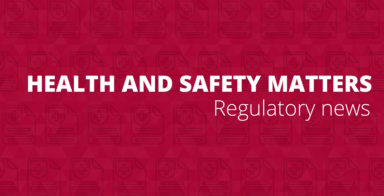Caring for patients, residents, and community clients exposes healthcare workers to unique and specific hazards – such as communicable diseases, ergonomic risks, and physical violence. These risk factors impact workers and can negatively affect patients, residents, families, and the organization.
In British Columbia, healthcare workers comprise about 12 percent of the workforce, but their injury rate is around 700 percent greater than the provincial average. About a third of injuries in the healthcare sector are related to overexertion – including musculoskeletal injuries like back, shoulder, neck, and wrist injuries. Almost 60 percent of injury claims related to workplace violence come from healthcare and social services.
Beyond the statistics, the human cost of injury can take a heavy toll. When a healthcare professional injures their back while moving a patient or suffers a fracture due to an incident of violence – the result is not just lost time at work. Injuries can contribute to limited mobility, chronic pain, stress, anxiety, depression, and burnout. Injured workers may struggle with performing daily activities, impacting their ability to enjoy their hobbies and social life.
Many workers leave the field due to acute or chronic injuries, contributing to the enormous challenges related to staffing shortages in healthcare.
Health and safety leadership in healthcare must go beyond mere compliance; it's a moral, ethical, and economic imperative that directly impacts staff well-being, patient and resident care, and organizational success. Imagine going to work every day knowing you have a 700% higher chance of being injured than workers in other industries.
An ethical imperative
Healthcare workers show up every day to care for others. But who is caring for them? As healthcare leaders, we have a moral obligation to protect them from workplace injury and illness. When a worker is injured – or made ill – a cascade effect impacts the people they care for, their families, colleagues, and the healthcare system.
It's crucial to remember that even seemingly "minor" injuries can significantly impact a healthcare worker's physical and mental health. The emotional trauma associated with workplace violence can be particularly profound and long-lasting.
Leaders are critical in developing a culture of care in their community by supporting an environment where the well-being, safety, and value of everyone – patients, residents AND staff – are prioritized. A culture of care emphasizes physical and psychological safety – caring for those who care for others.
In creating a workplace where everyone feels safe, valued, and respected, healthcare leaders can create supporting environments that reduce injury, improve staff morale, reduce turnover, and foster better patient, resident, and client experiences. What is your organization doing to prioritize health and safety?
Dollars and cents: The economic case for health and safety
In addition to lessening human costs, reducing workplace injuries can decrease compensation claims and lower insurance premiums. Fewer injuries also contribute to reduced absenteeism, improved staff retention and productivity, and enhanced reputation–leading to better recruitment.
In 2023, 101,714 work days were lost to injury in affiliate long-term care homes alone! These days are equivalent to losing 406 full-time employees from the sector. High turnover is a significant expense for healthcare organizations – exacerbated by skilled worker shortages and high competition for talent. A healthcare worker's average turnover cost in Canada is around $30,000.
Factors that contribute to the high cost of turnover include:
- Recruiting and hiring new staff – including advertising for positions, screening and interviewing applicants, and onboarding new hires.
- Training new staff – including the extensive training needed to provide safe care AND stay safe at work.
- Lost productivity – when a worker is off due to injuries, their colleagues may need to step in to cover the load – leading to decreased productivity and increased errors.
- Decreased morale – high turnover can lower the morale of the remaining staff. Witnessing a workplace injury, especially one involving a colleague, can be a profoundly distressing experience with potentially lasting mental health impacts.
The high cost of turnover in healthcare highlights the importance of investing in a culture of safety. When healthcare workers feel safe and valued, they are less likely to leave their jobs.
Beyond Compliance: What true health and safety leadership looks like
Leaders play a crucial role in creating a culture of safety in the workplace. When leaders visibly champion health and safety, it sends a powerful message that it is a top priority. Here are some practical ways leaders can demonstrate their commitment:
- Lead by example: Attend and participate in safety training alongside employees, promptly identify and report hazards, and get involved in safety inspections, audits, and incident investigations.
- Communicate the importance of safety: Make safety a priority in meetings and other communications. Highlight examples of good safety practices, celebrate safety wins, and openly address safety concerns.
- Invest in safety resources: Allocate sufficient budget for safety equipment, training, and initiatives and support employees in implementing innovative safety solutions.
- Employee engagement: Empower staff to identify hazards, suggest improvements, and actively participate in safety initiatives.
- Continuous improvement: Foster a learning culture and continuous improvement in health and safety practices. Track metrics and use data to drive decision-making.
- Training and education: Provide regular, relevant, and engaging health and safety training for all staff.
- Safety culture: Cultivate a culture where safety is valued, prioritized, and embedded in everyday practice.
Safety leadership makes a difference – for everyone
A strong safety culture in the healthcare workplace creates a safer environment for workers, patients, residents, and clients. Prioritizing health and safety is not just the RIGHT thing to do; it's the SMART thing.
I urge every healthcare leader to make this the year they prioritize safety–conduct a safety culture assessment, engage your staff, and implement a comprehensive safety action plan. Let's make healthcare a place where everyone thrives.
For resources, tools, and education to support your health and safety leadership, visit our website at safecarebc.ca.













